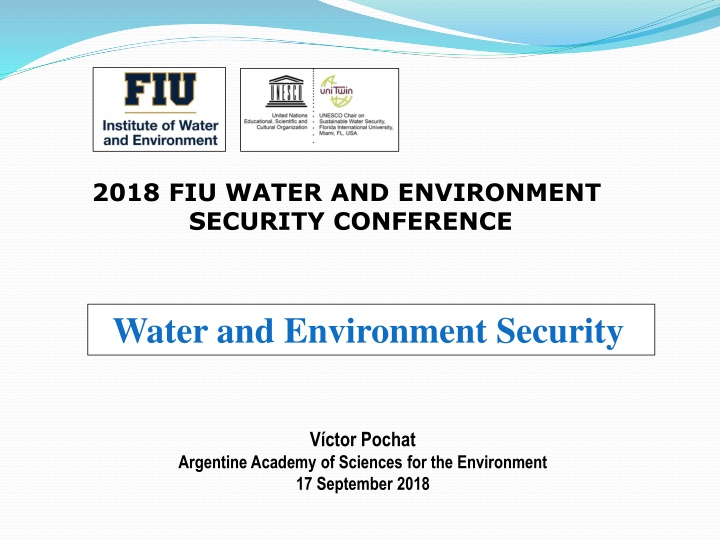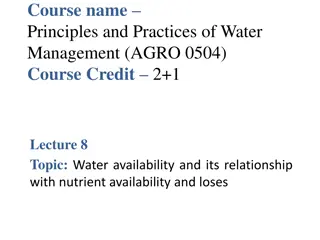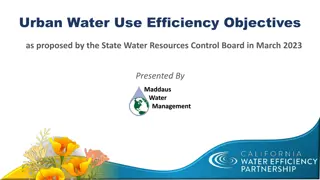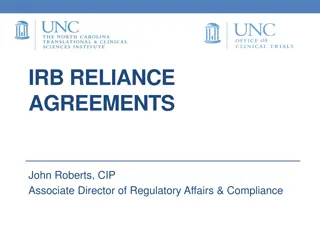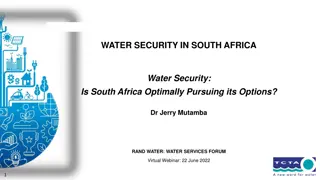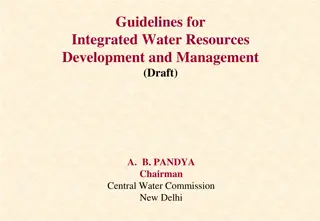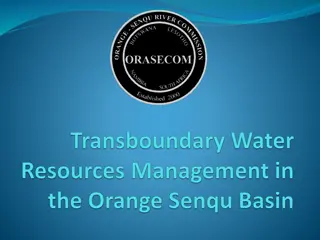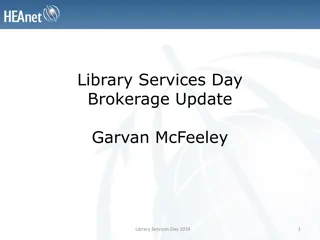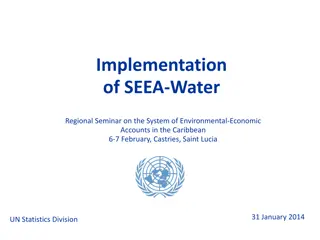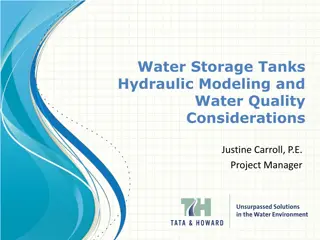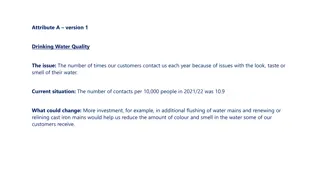Water Security in International Agreements
The concept of water security has gained prominence in recent years, with a focus on sustainable management of water resources. Leaders across various sectors are emphasizing the importance of water security and resilient water systems. Public policies are incorporating the paradigm of water security to address issues such as availability of water resources, vulnerability, and human development needs. Developing precise definitions is crucial to advancing water security goals, as seen in the widely accepted definition by Grey and Sadoff. This definition emphasizes the importance of balancing social, environmental, and economic outcomes in ensuring sustainable water management.
Download Presentation

Please find below an Image/Link to download the presentation.
The content on the website is provided AS IS for your information and personal use only. It may not be sold, licensed, or shared on other websites without obtaining consent from the author.If you encounter any issues during the download, it is possible that the publisher has removed the file from their server.
You are allowed to download the files provided on this website for personal or commercial use, subject to the condition that they are used lawfully. All files are the property of their respective owners.
The content on the website is provided AS IS for your information and personal use only. It may not be sold, licensed, or shared on other websites without obtaining consent from the author.
E N D
Presentation Transcript
2018 FIU WATER AND ENVIRONMENT SECURITY CONFERENCE Water and Environment Security V ctor Pochat Argentine Academy of Sciences for the Environment 17 September 2018
WATER SECURITY In recent years, the concept of water security -in an environmental context- has been included in numerous international declarations and agreements to define the strategic objective that countries should reach in relation to water resources management
WATER SECURITY Water security is high in the agenda of political and business leaders, and the academic community. As concerns about water resources grow, policy-makers, institutions, funders, and individuals are now using the term water security to express their views.
WATER SECURITY There is growing international consensus for increasing water security in a sustainable manner, and for building more resilient and robust water systems. However, as yet there is no consensus on framing and approaching what is a real and complex problem. Nevertheless, water security as a concept provides different disciplines and interest groups with a common language and starting point.
WATER SECURITY Public policies have been presented, using the paradigm of water security, using two different scopes: 1. Within the framework of a specific subject or discipline. For example, applied in - agricultural issues in relation to availability of water for irrigation and food security; - engineering projects, when analyzing risks of flooding and deficit in water supply, among others. 2. With a broader vision, within an interdisciplinary, inter-institutional and integrating scope, being the most recurrent themes: - availability of water resources, - vulnerability of people facing risks, - necessity to meet needs of human development (especially, food security), and - issues that concern the social and environmental sustainability.
WATER SECURITY In the second context, need to develop more precise definitions has been observed. Grey and Sadoff (2007) offer the most widely accepted definition, the availability of an acceptable quantity and quality of water for health, livelihoods, ecosystems, and production, coupled with an acceptable level of water-related risks to people, environments, and economies . This definition firmly embeds sustainable development , that seeks to ensure a triple bottom line of social, environmental, and economic outcomes. Moreover, it can be interpreted at different scales and it acknowledges that risks to people, environments, and economies will always persist, whatever is done to improve water security.
Second World Water Forum (The Hague, 2000) Water security at any level from the household to the global means that every person has access to enough safe water at affordable cost to lead a clean, healthy and productive life, while ensuring that the natural environment is protected and enhanced (GWP document)
Second World Water Forum (The Hague, 2000) Water security means ensuring that freshwater, coastal and related ecosystems are protected and improved; that sustainable development and political stability are promoted, that every person has access to enough safe water at an affordable cost to lead a healthy and productive life and that the vulnerable are protected from the risks of water-related hazards (Ministerial declaration)
Second World Water Forum (The Hague, 2000) The broad framing of the Ministerial Declaration includes seven variables: meeting basic needs securing the food supply protecting ecosystems sharing water resources managing risks valuing water governing water wisely
World Economic Forum (WEF) (2009) WEF prioritized water security as a global risk, stating that water security is the gossamer that links together the web of food, energy, climate, economic growth, and human security challenges that the world economy faces over the next decades
World Economic Forum (WEF) reports WEF considers the water crisis as one of the main risks the planet is facing. In 2015 report, as the risk that can cause more damage in the short term . In 2016 report, as the most important global risk for the economy in the next decade, with water being an urgent political issue, inextricably linked to climate change, economic stability and the displacement of the population
UN-Water (2013) Water security is the capacity of a population to safeguard sustainable access to adequate quantities of acceptable quality water for sustaining livelihoods, human wellbeing, and socio-economic development, for ensuring protection against water-borne pollution and water-related disasters, and for preserving ecosystems in a climate of peace and political stability
Organization for Economic Co-operation and Development (OECD) (2013) Achieving water security consists of maintaining acceptable levels of four water risks: Risk of shortage (including droughts): Lack of sufficient water (in the short and long term) for the beneficial uses of all users. Risk of inadequate quality: Lack of water of suitable quality for a particular purpose or use. Risk of excess (including floods): Overflow of the normal confines of a hydraulic system (natural or built), or the destructive accumulation of water over areas that are not normally submerged. Risk of undermining the resilience of freshwater systems: Exceeding the coping capacity of surface or groundwater bodies (the system ) and their interactions, possibly crossing tipping points, causing irreversible damage to the system s hydraulic and biological functions.
Some relevant aspects of the definitions on Water Security In general, the definitions are not restricted to assessing the physical availability of water, in quantity, quality and opportunity, but rather are aimed at contrasting available water resources with the requirements of people, the economy and the environment. That is, water security is understood as a problem of people and development of society and not of nature.
Some relevant aspects of the definitions on Water Security The concept of water security incorporates, among its elements, environmental sustainability, and the sustainability of supplies and services associated with water. This dimension of the concept makes necessary to analyze the physical availability of water resources in the long term, as well as the capacity of management systems to respond and adapt to a scenario in which such availability may undergo substantive changes, both in terms of the natural system as in relation to the human system (social, economic and political changes), or even to simply allow the maintenance of current conditions and levels of service over time.
Some relevant aspects of the definitions on Water Security An aspect always present in the definitions is the existence of risk. This responds to the fact that, by its nature, the water resource is a variable resource, in temporal and spatial terms, and subject to extreme events. This situation is aggravated by climate change. We must add the uncertainty related to social, economic and political processes that affect the demand, supply and management of water resources.
Some relevant aspects of the definitions on Water Security Risk is gathered with particular force in the OECD approach (2013), where the water security objective is related to an acceptable level of risk". This requires determining the appropriate level of security, considering - frequency, magnitude and intensity of risks, -degree of exposure to them, and - defining the social distribution of the hazards and - the costs associated with their reduction. Thus, in practice, to provide adequate water security it is necessary: - discuss policy options, - evaluate the relationship between cost and effectiveness of proposals, - discern between preventive and reactive approaches, - carry out processes with the participation of stakeholders, and - decide on different forms of financing, among other aspects.
Some relevant aspects of the definitions on Water Security UN-Water (2013) definition expressly identifies "the populations" as the subject that should have the necessary capacities to provide adequate water security, and not only the State as it could be interpreted in general. This means that this approach would be a matter in which local authorities would have relevant responsibilities, complementary to the inalienable and imprescriptible role that the State must fulfill. This definition would be echoing the role that non-formal organizations and institutions that administer water as a commonly used resource, in accordance with culturally accepted practices, would have in certain realities.
Some relevant aspects of the definitions on Water Security A different approach links water security to the geopolitical dimension, associating it with the issue of the security of nations in general. In this dimension, the UN-Water definition (2013), like the Ministerial Declaration of the II World Water Forum, echoes the political-type conflict that could generate the use of water resources in an increasingly competitive scenario between groups or nations, in relation to transboundary water resources, and incorporates as a characteristic of water security "a climate of peace and political stability".
FROM INTEGRATED WATER RESOURCES MANAGEMENT (IWRM) TO WATER SECURITY The concept of water security is closely aligned to Integrated Water Resources Management (IWRM) as all its principles, particularly the idea of integration, are embedded in the concept of water security. Indeed, IWRM provides an integral and important part of the pathway towards increasing water security.
FROM INTEGRATED WATER RESOURCES MANAGEMENT (IWRM) TO WATER SECURITY IWRM is a process which promotes the coordinated development and management of water, land, and related resources in order to maximize the resultant economic and social welfare in an equitable manner without compromising the sustainability of vital ecosystems. (GWP, 2000) IWRM is not without its critics: Some authors suggested it focuses too much on process (enabling environment, institutional framework, management instruments) and is not specific in what it is meant to achieve. Others say IWRM has rarely, if ever, been achieved in reality.
FROM INTEGRATED WATER RESOURCES MANAGEMENT (IWRM) TO WATER SECURITY The concept of water security overcomes those criticisms by moving the focus from process to outcomes. Thus IWRM is important but is not an objective by itself. What ultimately matters is to improve services that good water management provides (supplying good quality water, protecting people from droughts and floods, and providing a healthy environment for people and ecosystems). These are the end goals of an integrated approach and together they comprise the concept of water security.
FROM INTEGRATED WATER RESOURCES MANAGEMENT (IWRM) TO WATER SECURITY IWRM and water security clearly have the same general objective improving the conditions related to water for human wellbeing. Are these concepts overlapping or to what extent they are complementary?. Both take a broad view of the issues related to water and ask for an integrated approach across sectors and scales. Absolute water security can never be achieved because conditions will change, water demand will continue to grow, and limited financial resources will constrain what can be done. IWRM will help improve water security although improvements will depend largely on the amount and quality of resources invested in the effort. Thus, IWRM and water security are symbiotic and this is factored into the continuous IWRM planning cycle
SOME FINAL THOUGHTS Why use the concept of water security? The analysis of the water security of a country or of a specific territory (region, province, municipality or basin) presents several advantages that have contributed to its popularization at a global level: Emphasizes the importance of water in social and economic development, and the need and responsibility of its prioritization by governments. The concept of water security focuses on the problems that affect people and not on strategies to solve them. In this way, the water theme may be inserted more easily in the public policies of the countries.
SOME FINAL THOUGHTS Why use the concept of water security? Helps to identify the issues and areas that are critical for proper water management, and the interdependencies that they have with other public policies. The concept of water security has a wide and varied scope, with multiple dimensions, which deals with the totality of water's relationship with society. Defines criteria to establish goals and evaluate public policies based on the analysis of the risks that are acceptable and the availability that is adequate for the population. The emphasis in the mitigation of risks entails the need to identify the threats, vulnerability and uncertainties that water management must face and assess its capacity to adapt to new scenarios.
SOME FINAL THOUGHTS Why use the concept of water security? Favors the comparison of performance in specific subjects and situations. The analysis of water security is an approach that provides elements to make comparable experiences and results of water management in different countries and realities, transmit the lessons learned and extend the best practices of the sector. In summary, the systematic analysis of water security can be of great interest and usefulness for the countries, conceived as a tool for comprehensive analysis, diagnosis, definition of objectives, evaluation and comparison of performance.
